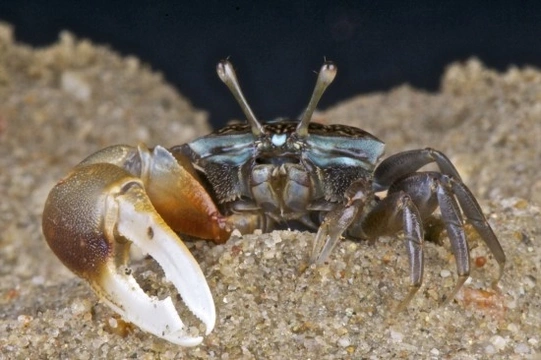Pets
Pets for studWanted petsBreedersAccessories & services
Knowledge hub
Support
Support & safety portal
Keeping pet fiddler crabs
Fiddler crabs come in around 90 different species, and the smaller members of the class can live quite happily and without hugely complex care requirements in their own aquarium within the home. They grow to a maximum size of around two inches across, making them easy to observe and watch going about their business, but not so large that they require a huge aquarium or tank to thrive.
The fiddler crab gets its name from the shape of the claw on the males of the species, which are uneven, with one being small and the other being very large proportionally to their body size, and shaped like a violin, hence the name! The females have two matching small claws.
In the wild, some fiddler crab species reside on beaches and within the inner tidal zone of the ocean, burrowing into muddy hides when the tide goes out. Other species live in brackish swamps with slow-moving water currents. While some pet stores sell fiddler crabs as freshwater pets, they are in fact native to brackish and salt water, and while they do not have the same complex care requirements as animals that require a full marine tank set up, this does mean that they will not thrive in the average tropical freshwater aquarium.
If you are looking to keep pets that are relatively low maintenance, safe, interesting and something a little different to the norm, fiddler crabs might be a good pick.
In this article, we will cover some of the basics of housing and caring for pet fiddler crabs to get you started.
How to choose a fiddler crab
As mentioned above, some pet stores that are not overly familiar with correct fiddler crab care will keep their crabs in a freshwater set up, but this does not provide an appropriate habitat and can shorten your crab’s lifespan and lead to health issues. Only buy from a retailer that keeps their crabs in brackish water, and who can speak knowledgably to you about their care.
Look for crabs that are active, moving around and that appear in good health, with all of their legs and fully formed claws and no obvious signs of ill health.
Brackish water
In order to provide the appropriate water quality for your fiddler crabs, you will need to produce brackish water for their tank using special aquarium salt from an aquatic retailer. Never use plain sea salt or table salt within their tank!
Knowing how much salt to add to the water can prove challenging, so it is wise to invest in a hydrometer, which will measure the specific gravity of the water, and indicate the appropriate level. A specific gravity of between 1.005 and 1.010 is ideal for fiddler crabs to thrive.
While it is important to get the salinity balance of the water just right, fiddler crabs are hardy animals that can live within a fairly wide range of different water salinity levels, and so they do not require the type of high-tech equipment and close monitoring that true marine fish tanks do.
Temperature range and tank heating
Fiddler crabs require a water temperature that is rather higher than the ambient household temperature, for which you will require a tank heater of the appropriate size. A temperature of between 24 and 29 degrees Celsius is ideal, and again, allows for a variation in temperatures for your crabs without causing a problem.
Water and land
Fiddler crabs do not spent all of their time in the water, and need access to land as well. This can be provided by using a wide and relatively shallow tank rather than one that is very deep, and by half filling it with water. Tank furniture, rocks and equipment can then be placed into the tank that stick up above the water level, to give your crabs access to land as well as water. Sloping the substrate of the tank can help with this too, but however you achieve it, you must provide some means of allowing your crabs to come and go from the water as they please.
What to feed to fiddler crabs
Fiddler crabs, like most other crab species, are natural scavengers and will eat whatever they can get their claws on! Sinking pellet food and freeze-dried shrimp and plankton are fine to feed to your crabs, as is organic matter and vegetation, and they are not at all hard to feed.
Healthy fiddler crabs will moult their shells regularly before growing a new one, and they may ingest the old skeleton once shed too, for the added calcium that it provides. Occasionally, the fiddler crab may lose a leg as part of the moulting process, but this is not a major cause for concern and over time, a replacement leg will grow back!



